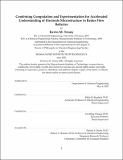Combining Computation and Experimentation for Accelerated Understanding of Electrode Microstructure in Redox Flow Batteries
Author(s)
Tenny, Kevin M.
DownloadThesis PDF (37.68Mb)
Advisor
Brushett, Fikile R.
Chiang, Yet-Ming
Terms of use
Metadata
Show full item recordAbstract
Improving grid energy storage is crucial for integrating renewable energy options and reducing anthropogenic carbon emissions. Redox flow batteries (RFBs) are a promising long-duration energy storage technology, whose modular energy and power scaling complements diurnal, weather-dependent electricity generation. Pumped from external tanks, liquid-phase electrolytes containing redox active species are dispersed through the RFB reactor to undergo an interconversion of oxidative states, releasing electrons to pass through external loads before the electrolytes return to their respective tanks. The electrodes are encased in the RFB reactor and fulfill several critical functions for successful operation: They facilitate advection through the porous media, afford active sites for redox events, and transfer liberated electrons through a solid matrix. Consequently, electrode topologies influence multiple transport scales that require precise metering to ascertain performance metrics. However, most electrode analysis relies on experimentation or modeling to analyze structures that engender favorable performance; but when combined, the two can provide a deep analysis of electrode structure/function relationships.
In this dissertation, I first provide an assessment of the U.S. long-duration energy storage market, outlining the industry competitiveness and attractiveness, as well as discussing headwinds for RFBs seeking to enter the market. This work then focuses on exploring multiple electrode topologies, both experimentally and computationally, drawing relationships between fluid dynamic and electrochemical functions in diverse electrolyte environments. Further, I examine a promising potentiodynamic electrochemical method that can improve our understanding of flow cell performance. Next, I demonstrate the progression of high- and low-dimensional macrohomogenous models and their applications for screening structural and operational benchmarks, culminating in regressive models for targeted domain optimization. I conclude with parameter sweeps across artificially designed electrodes, revealing key microstructural features that lead to augmented functionality before offering my perspective on various business and research directions for the field.
Date issued
2023-06Department
Massachusetts Institute of Technology. Department of Chemical EngineeringPublisher
Massachusetts Institute of Technology